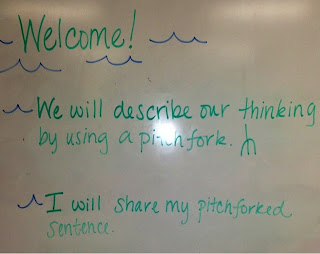You know how each new staff development seems to produce the latest and greatest idea. We throw ourselves into it for a year and then turn a blind eye when presented with something even more cutting edge. I'm thankful that my district has stuck with a second year of implementation of the Fun
The first of these fun 5 is framing the lesson. (That's where the title of this post comes in- frame, picture...Get it?...Anyone??)
The top of the frame is what "We will..." learn today.
The bottom is how "I will..." prove that I've learned the material by the end of the lesson.
Everything in the middle is stuff and things- activities for how you will teach the concept.
So let's frame this post:
We will identify the components of an effective lesson frame.
I will create a meaningful lesson frame for an upcoming lesson.
This frame would be verbally acknowledged at the beginning of the class period so that students know what they will learn and how they will be accountable for that learning.
It is important to point out the verbs here:
"We will identify..." and "I will create...".
During the lesson, the teacher moves the students to a higher level of thinking through the carefully chosen stuff and things. When lesson planning, it is essential to establish your lesson frame first in order to have a clear goal. Class activities should then be chosen according to their ability to help students achieve this goal. It makes instruction more purposeful.
So that's what a lesson frame is. Let's talk about why the frame is important.
Student benefits:
- provides a visual cue of what is expected
- establishes an expectation that all are included/involved
- helps students create relevance
- allows distracted or tardy students (re)engage
Teacher benefits:
- create a clear intent for each lesson (all other decisions are then made to support that intent)
- keeps the teacher on track and purposeful
- closing task ("I will...") provides more immediate feedback of student's ability
Here is an objective/closing cheat sheet to help you as you plan your lessons for this new year:
How to write a good objective: | How to write a good closing: |
-Review my lesson plan | -Review my lesson plan |
-Imagine a student asks me, “What are we learning today?” | -Ask myself, “What is the MOST critical element for students to understand today?” |
-My answer is the “We will…” statement | -That is your “I will…” statement |
-My objective is specific to the day’s lesson and written in student-friendly language | -My closing is specific to the day, student-friendly, and can be completed in the last 5ish minutes of the lesson* |
*The closing comes at the end of the lesson, not necessarily at the end of class.
These tips can be used in all grade-levels and content areas. It allows both the teacher and students to focus on the big picture- student learning and success.

